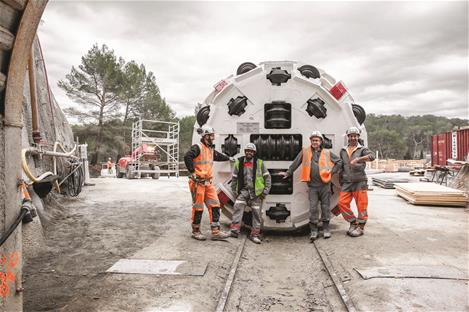Workhorse Machine makes progress in
Difficult Ground
A rebuilt Robbins 3.5 m (11.5 ft)
diameter Main Beam TBM has yet another milestone to add to its storied career:
an unexpected cavern, encountered and successfully passed through.
Contractor Eiffage Civil Engineering
is operating the machine, which launched in 2017 for the Galerie des Janots
project in La Ciotat, France. The cavern, studded with stalactites and
stalagmites and measuring 8,000 cubic meters (283,000 cubic ft) in size, was
grazed on the tunneling operation’s left side. The crew named the cavern
“grotte Marie Lesimple” after their site geologist.
“We hit the corner of it. To cross it,
we had to erect a 4 m (13 ft) high wall of concrete so the TBM would have
something to grip against,” explained Marc Dhiersat, Project Director of
Galerie des Janots for Eiffage. A small door allowed access inside the
cavity, which formed naturally at a point 60 m (200 ft) below the surface. The
TBM was started up and was able to successfully navigate out of the cavern in
eight strokes without significant downtime to the operation.
“This is certainly unusual, to come
across a cavern of this size and significance. It is somewhat related to the
geology, with karstic and volcanic formations having the most potential for
underground cavities,” said Detlef Jordan, Robbins Sales Manager Europe. Karst
cavities were a known risk during the bore, but the cavern was not shown in
vertical borehole reports conducted from the surface along the alignment.
A further 1.8 km (1.1 mi) will need to
be tunneled before the 2.8 km (1.7 mi) tunnel is complete. “It is possible
there could be more unknown caverns. We have a geotechnical BEAM system on the
machine, and are conducting probe drilling, shotcreting, and maintenance in a
separate shift,” said Dhiersat. The BEAM system, standing for Bore-tunneling
Electrical Ahead Monitoring, is a ground prediction technique using focused
electricity-induced polarization to detect anomalies ahead of the TBM.
The crew encountered difficult ground
conditions early on in the bore, consisting of limestone with powdery clays.
“When the machine is boring it does well. We have good production and it’s a
good machine for hard rock. But sometimes it’s not hard rock that we encounter,”
said Dhiersat. The weak rock and clay conditions necessitated ground
support including resin-anchored bolts and rings in bad ground, topped with a
10 to 15 cm (4 to 6 in) thick layer of shotcrete. Despite five months of poor
ground conditions, Eiffage is optimistic that conditions will improve and the
tunnel will be complete in the next four to five months.
Galerie des Janots is one of the
fourteen operations designed to save water and protect resources, which are
being carried out by the Aix-Marseille-Provence metropolis, the water agency
Rhône Mediterranean Corsica, and the State Government. The future Janots
gallery will replace existing pipelines currently located in a railway
tunnel—these original pipes have significant deficiencies with estimated water
losses of 500,000 cubic meters (132 million gallons) per year.
The completed tunnel will pass under
Le Parc National des Calanques, with cover between 15 and 180 meters (50 to 600
ft), in order to replace the pipes that are currently being utilized for the
water supply networks. “The current pipes have a capacity of transit limited to
330 liters (87 gallons) per second, which is largely insufficient in the summer
period. The objective of the operation is to secure the lines and increase
capacity to 440 liters (116 gallons) per second,” said Dhiersat. For further information visit http://www.therobbinscompany.com/


